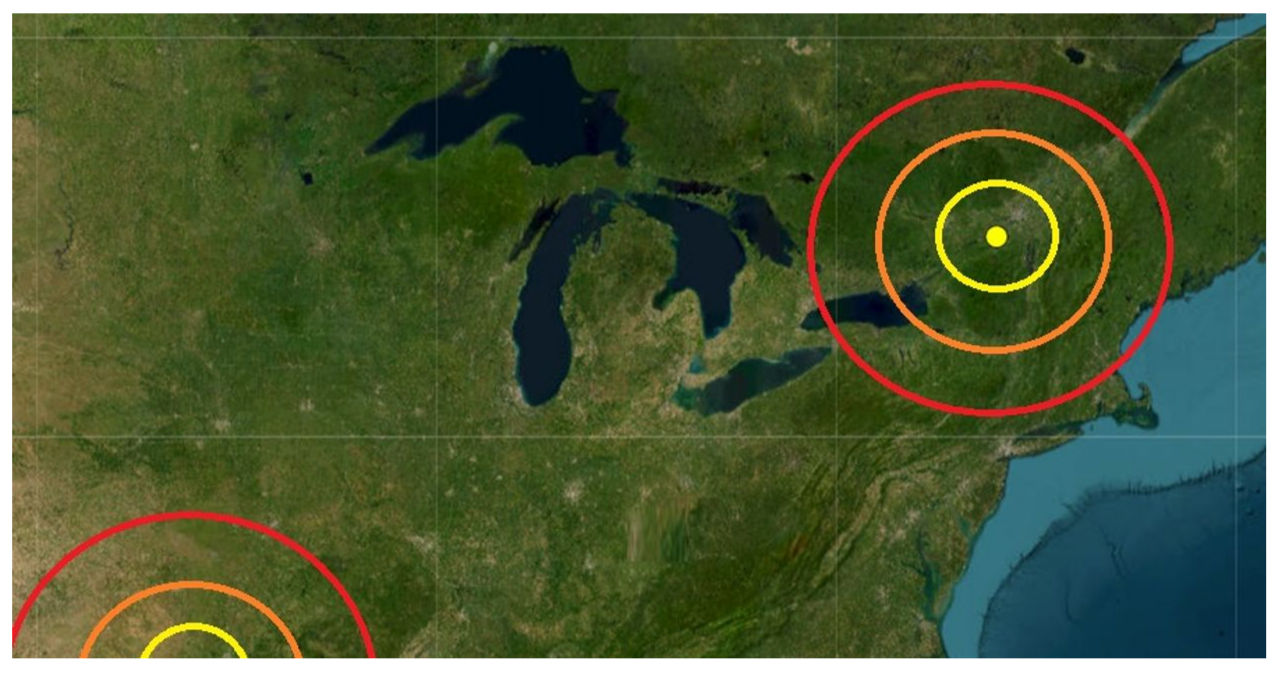Jamiesfeast – In the past few days, Oklahoma and New York have experienced moderate to strong earthquakes, resulting in a significant number of reports to the USGS. Through their online reporting website, called “Did you feel it?”, tens of thousands of individuals have provided accounts of feeling shaking or witnessing objects being moved or knocked over. Fortunately, there have been no reported injuries associated with these earthquakes at this moment.
A moderate earthquake with a magnitude of 3.2 hit just north of the U.S./Canada border above New York state. The earthquake occurred at 7:37 am on Thursday and generated 377 reports of “Did you feel it?” The epicenter was located just outside of Huntingdon, Canada, at a depth of 7 km. The tremors were felt in the Ottawa and Montreal suburbs, as well as in large parts of upstate New York. The epicenter was situated halfway between Montpelier, Vermont, and Ottawa, Canada.
Earthquakes that have a magnitude of 2.0 or lower are usually not felt or heard by people. However, once they surpass 2.0, like the event mentioned here, they become more noticeable to an increasing number of individuals. Although it is possible for damage to occur with earthquakes of magnitude 3.0 or higher, significant destruction and casualties typically do not occur until the magnitude reaches 5.5 or higher.
New York has a rich history of earthquake activity that has affected every corner of the state, according to the Northeast States Emergency Consortium (NESEC). Since the initial recorded earthquake on December 19, 1737, there have been more than 550 earthquakes within New York’s state borders up until 2016. Additionally, the state has experienced significant ground shaking from earthquakes originating in neighboring U.S. states and Canadian provinces. The majority of these earthquakes have occurred in the greater New York City area, the Adirondack Mountains region, and the western part of the state.
New York has experienced numerous earthquakes, ranging from weak tremors to more destructive events. Out of the 551 earthquakes documented between 1737 and 2016, five were classified as “damaging.” These significant earthquakes occurred in 1737, 1929, 1944, 1983, and 2002.
Last night, a powerful earthquake shook Oklahoma, causing widespread tremors across the Midwest. The epicenter of this earthquake was located outside of Prague, between Oklahoma City and Tulsa in central Oklahoma. The impact was felt across a vast region, stretching from Dallas, Texas to north-central Kansas, and even reaching as far as southern Missouri and western Arkansas. A total of 24,475 individuals reported feeling the effects of this magnitude 5.1 earthquake, which originated at a depth of 8 km.
Last night’s earthquake, which occurred at 11:24 pm, marks the fourth most powerful earthquake ever recorded in Oklahoma. Over the past few months, Oklahoma has experienced a notable increase in seismic activity, with two earthquakes exceeding a magnitude of 4.0 hitting a different suburb of Oklahoma City just last month.
The earthquake in Oklahoma, on the other hand, did a lot of damage. It broke windows, knocked down brick walls, and threw things off of shelves and tables in homes and businesses.
While the New York earthquake was a result of natural forces, scientists believe that people may have caused the Oklahoma earthquake.
Beginning in 2009, Oklahoma experienced a surge in seismicity according to USGS. “This surge was so large that its rate of magnitude 3 and larger earthquakes exceeded California’s from 2014 through 2017,” writes USGS in a report analyzing the increase in seismicity here. “While these earthquakes have been induced by oil and gas related process, few of these earthquakes were induced by fracking. The largest earthquake known to be induced by hydraulic fracturing in Oklahoma was a M3.6 earthquakes in 2019. The largest known fracking induced earthquake in the United States was a M4.0 earthquake that occurred in Texas in 2018. The majority of earthquakes in Oklahoma are caused by the industrial practice known as “wastewater disposal”. Wastewater disposal is a separate process in which fluid waste from oil and gas production is injected deep underground far below ground water or drinking water aquifers. In Oklahoma over 90% of the wastewater that is injected is a byproduct of oil extraction process and not waste frack fluid.”
The Oklahoma Geological Survey is warning residents of Oklahoma that there will probably be more earthquakes, some of which will be larger and cause more damage.
“We should expect several strong aftershocks in the coming weeks that may be widely felt,” State Seismologist Jake Walker said. “Whereas most aftershocks are smaller than the main shock, a very small fraction of aftershocks result in a larger earthquake than the main event. The seismic hazard remains high in the area.”
Walter added, “The event took place in a location that is very similar to the area where the 2011 Prague earthquake, which had a magnitude of 5.7, occurred. This earthquake was determined to be caused by activities related to wastewater disposal. We will keep a close watch on the seismic activity and offer our support to the Oklahoma Corporation Commission, other state agencies, and the general public.”
The Oklahoma Corporation Commission is currently conducting an investigation to determine if the recent earthquake was caused by the injection of wastewater.

